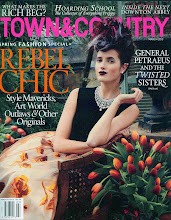 Photos courtesy of Rizzoli
Photos courtesy of RizzoliA Horst photo of the Lampham Living Room in Greenwich, Connecticut where a floral chintz grounds the room, covering a turkish divan and chair. The mix with antiques sets the stage for comfortable entertaining.
If there is one book you must add to your design library this season, this is it. Often referred to as the most influential American decorator, interior designer Billy Baldwin's work and life have been painstaikingly chronicled by Adam Lewis in Billy Baldwin: The Great American Decorator from Rizzoli. Spending five years on the research, Lewis spoke to past clients, employees, friends and assistants including Deeda Blair, Edward Lee Cave, Albert Hadley and Harry Hinson, culling their anecdotes and the story of his rise in this fantastic book. Many of the images in the book are being published for the first time. I own Billy Baldwin Decorates and Billy Baldwin Remembers, the rare out of print books he published in 1973 and 1974, but many of the photos are grainy and black and white. In this book, the color reproduction is bright and clear, and the genius of the most important designer of the twentieth century really comes across. The photos have inspired countless young decorators and will continue to do so for years to come.
 Baldwin was quoted in the New York Times in 1965 saying, "We in this country have the greatest taste level in the world. Maybe it's because we are young; we've always been on the way up and have never had to come down. I can't tell you how American I am." He believed America had the best decorating in the world, since we did not have to rely on past periods of design styles like the English and French. As a young country, he thought, we were full of fresh design ideas, and could do thinks in design that had never been done before.
Baldwin was quoted in the New York Times in 1965 saying, "We in this country have the greatest taste level in the world. Maybe it's because we are young; we've always been on the way up and have never had to come down. I can't tell you how American I am." He believed America had the best decorating in the world, since we did not have to rely on past periods of design styles like the English and French. As a young country, he thought, we were full of fresh design ideas, and could do thinks in design that had never been done before.He was raised well to do in Baltimore and surrounded by cultured influences from a young age, which prepared him for high society early on. After trying several jobs without success, his mother helped launch his career in design, by introducing him to his first boss, Ruby Ross Wood. Wood lovingly called him Billy B., and staunchly believed in his talents. Along with a cadre of stylish and influential friends, including Van Day Truex the president of Tiffany, Nicholas de Gunzberg the editor at Vogue, Woodson Taulbee, owner of Woodson Papers, and Linda Porter, Brooke Astor took him under her wing. His client's adored him, and the legacy he leaves is that of simplicity and comfort in design, masterful mixing color as well as period styles and a tailored ease.
 A watercolor by the late Mark Hampton, depicts Cole Porter's Waldorf Towers library with its famous often copied brass bookcases and chocolate walls.
A watercolor by the late Mark Hampton, depicts Cole Porter's Waldorf Towers library with its famous often copied brass bookcases and chocolate walls. Baldwin loved reproduction furniture, and advised clients to use copies in high use areas. He saved antiques for low use spots. Being comfortable was key, and this came across in everything he did. Here, in a living room for a young client in Madrid, he used the light floors as a guide for the color scheme of the room, and filled the space with comfortable seating areas.
Baldwin loved reproduction furniture, and advised clients to use copies in high use areas. He saved antiques for low use spots. Being comfortable was key, and this came across in everything he did. Here, in a living room for a young client in Madrid, he used the light floors as a guide for the color scheme of the room, and filled the space with comfortable seating areas. In a Florida home, Baldwin combined white and blue cotton fabrics with pops of red. He loved natural as well as man made materials, and even used vinyl on walls to get the glossy look of lacquer.
In a Florida home, Baldwin combined white and blue cotton fabrics with pops of red. He loved natural as well as man made materials, and even used vinyl on walls to get the glossy look of lacquer. Looking to Brighton Pavillion for inspiration, Baldwin created a haven for hair at the Kenneth Salon in the early 60's. He was not big on commercial projects, but this one was well worth it. With exotic patterns, fretwork details and a red, yellow and white scheme, Kenneth was the ne plus ultra salon for the chic set.
Looking to Brighton Pavillion for inspiration, Baldwin created a haven for hair at the Kenneth Salon in the early 60's. He was not big on commercial projects, but this one was well worth it. With exotic patterns, fretwork details and a red, yellow and white scheme, Kenneth was the ne plus ultra salon for the chic set. Baldwin's New York apartment at 106 East 61st Street had a Korean screen behind the cream sofa, and dark walls. He liked a classic Lawson sofa silhouette, and used it time and time again. The slipper chair he often used was based on the center section of a Lawson, without arms.
Baldwin's New York apartment at 106 East 61st Street had a Korean screen behind the cream sofa, and dark walls. He liked a classic Lawson sofa silhouette, and used it time and time again. The slipper chair he often used was based on the center section of a Lawson, without arms. Fearlessly combining zebra, big game heads, and patterned fabrics, this guest house in Bedford feels country yet sophisticated.
Fearlessly combining zebra, big game heads, and patterned fabrics, this guest house in Bedford feels country yet sophisticated.Baldwin did very well in his business, and worked for over fifty years. Sadly, he died penniless and alone on Nantucket in a cottage his friends provided, after years of neglecting to pay back taxes from his mother's estate. He narrowly avoided going to jail for the amount he owed, and this blight deeply embarrassed him. The design legacy he leaves behind is epic and his work will continue to spawn legions of imitators-- which, as you know, is the best form of flattery.

























6 comments:
Classic style...come join my giveaway
A wonderful addition to any design aficionados’ library. Highly recommended.
I grew up a few blocks away from where BB did, and so have known about him my whole life. This fall, I went to an all-day lecture on BB in Baltimore at a grand house (now museum) where he spent much time. Adam Lewis was the featured speaker and was wonderful. It was such a great day, with people who knew BB as friends in B-more and others who worked with/for him.
I am hoping to get the book as a present in a few days!
Oh the classic and timeless work of Billy Baldwin...perfection!! Can't wait to add this one to my ever growing collection of design books...
I am really looking forward to this book. I had understood that friend and former client Mrs Gilbert (Kitty) Miller had settled his tax liability. Remembering a NEW YORK TIMES MAGAZINE color spread on his cottage not long before his passing, I don't think he died a forgotten man.
I found this post through Pinterest. It's wonderful. And now Im picking up the book this week!! Thanks :)
Post a Comment